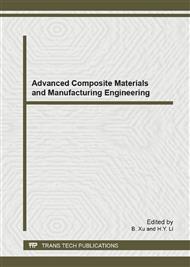[1]
M. Ezaki, M. Obara, H. Kumagai and K. Toyoda: Appl Phys Lett. Vol. 69 (1996), p.2977.
Google Scholar
[2]
K. Xu, J. Xu and P.Z. Deng: J . Cryst Growth. Vol. 193 (1998), p.127.
Google Scholar
[3]
P. Waltereit, O. Brandt and M. Bamsteiner: Phys. Status. Solid. Vol. 180 (2000), p.133.
Google Scholar
[4]
P. Waltereit, O. Brandt and M. Bamsteiner: J. Cryst. Growth. Vol. 217 (2000), p.143.
Google Scholar
[5]
P. Waltereit, O. Brandt and M. Bamsteiner: Nature. Vol. 406 (2000), p.133865.
Google Scholar
[6]
S.I. Hirano and T. Hayashi: J Am Ceram Soc. Vol. 70 (1987), p.133171.
Google Scholar
[7]
J. Jimonez-Becerril, P. Bosch and S. Bulbulian: J Nucl Mater. Vol. 185 (1991), p.304.
Google Scholar
[8]
Y. Kawamura, M. Nishikawa and K. Tanaka: J Nucl Sci Technol. Vol. 29 (1992), p.436.
Google Scholar
[9]
W. Lin, X.D. Bai and Y.H. Ling: Rare Met. Mater. Eng. Vol. 32 (2003), p.995.
Google Scholar
[10]
J. Zou and T.H. Huang: Acta phys. sin. Vol. 55 (2006), p.3536.
Google Scholar
[11]
T.H. Huang and S.M. Zhou: J. Synth. Cryst. Vol. 36 (2007), p.1249.
Google Scholar
[12]
S. Kuck: Chem. Phys. Vol. 204 (1999), p.133387.
Google Scholar
[13]
G.L. Peng, Y. Zhuang and J. Zou: J. Synth Cryst. Vol. 34 (2005), p.399.
Google Scholar
[14]
W.R. Tinga and W.A.G. Voss: Microwave Power Engineering[M]., New York: Academic Press, 1968. 73-78.
Google Scholar
[15]
W.H. Sutton: Am. Ceram. Soc. Bull. Vol. 68 (1989), p.376.
Google Scholar
[16]
Z.Z. Jiang: Nucl. Tech. Vol. 26 (2003), p.956.
Google Scholar
[17]
M.G. Zhao and W.L. Yu: Crystal Field Theory(M). Sichuan Education Press, Chengdu, 1988 in Chinese.
Google Scholar
[18]
M.G. Zhao: Crystal Field And Electron Paramagnetic Resonance Theory(M). Science Press, 1990 in Chinese.
Google Scholar
[19]
O. Brandt, R. Muralidharan and P. Waltereit: Appl. phys. lett. 75 (1999), p.4019.
Google Scholar
[20]
M.G. Zhao, M.L. Du and G.Y. Sen: J. Phys. C: Solid State Phys. Vol. 20 (1987), p.5557.
Google Scholar
[21]
D. Curie, C. Barthou and B. Canny: J. Chem. Phys., Vol. 61 (1974), p.3048.
Google Scholar
[22]
M.G. Zhao: The ligand field theory[M]. Guizhou People Press, 1986 in Chinese.
Google Scholar
[23]
Y.Y. Yeung and C. Rudowicz: Comput. Chem. Vol. 16 (1992), p.207.
Google Scholar


